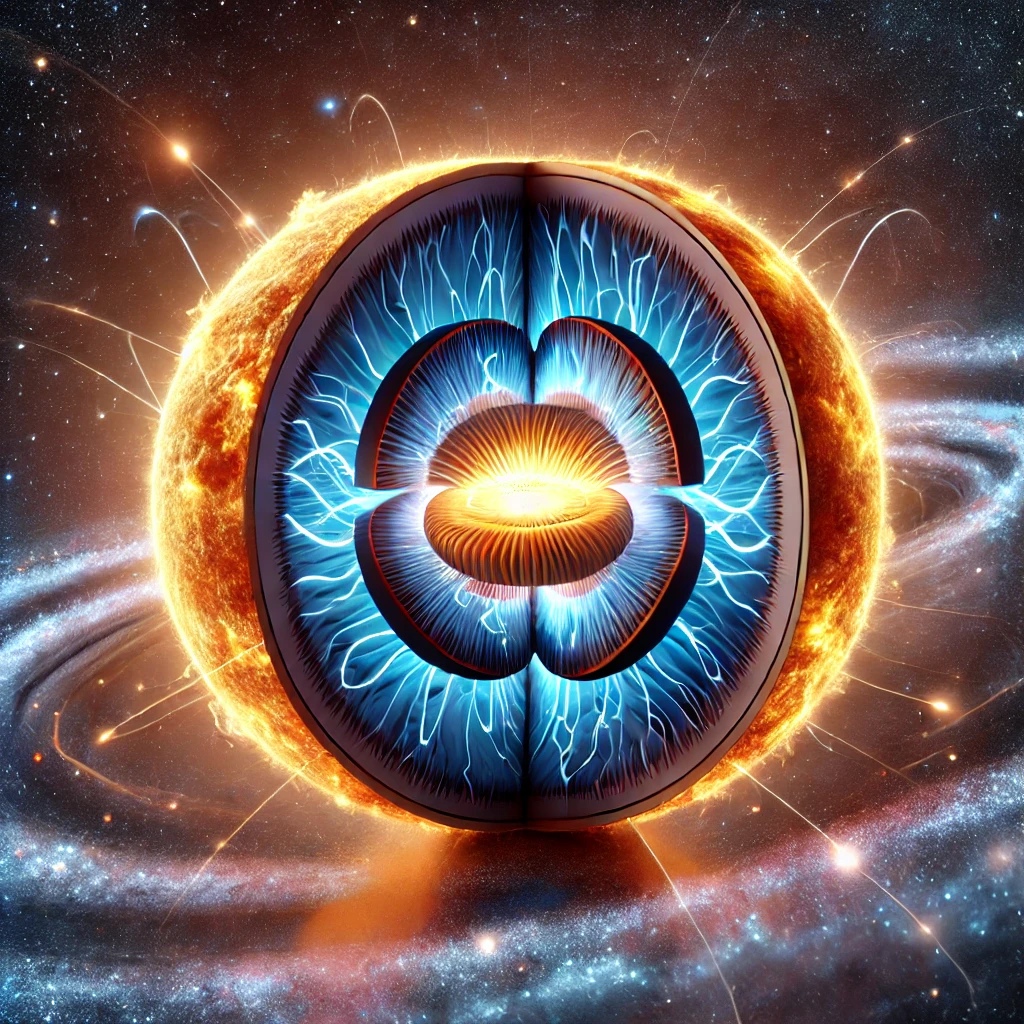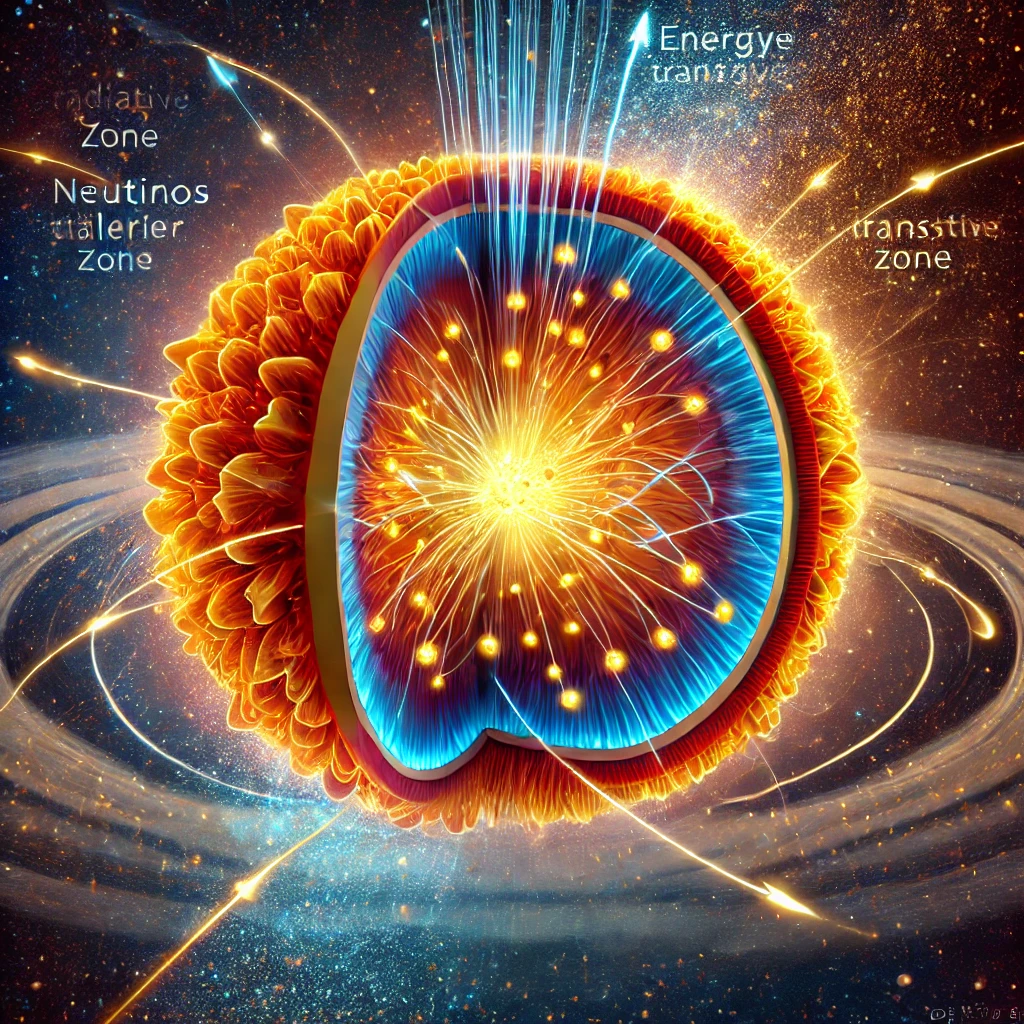Neutrinos, nearly massless and electrically neutral subatomic particles, play a crucial role in the energy transport and structural evolution of stars. Their weak interactions enable them to escape dense stellar cores, carrying significant energy, especially during core-collapse events in massive stars. Despite their elusive nature, understanding neutrino dynamics is essential for accurate stellar models.
In this paper, the impact of neutrinos on stellar interiors will be examined, focusing on their interaction mechanisms and role in energy transport through theoretical models and mathematical formulations.

Theoretical Background on Neutrinos and Stellar Dynamics
Neutrinos are fundamental particles belonging to the lepton family, proposed by Wolfgang Pauli in 1930 to resolve the apparent violation of energy conservation in beta decay. Their discovery revolutionized our understanding of particle physics and nuclear processes within stars. Neutrinos have three known flavors: electron, muon, and tau neutrinos, each capable of oscillating between forms, a phenomenon first observed in solar neutrino experiments. This oscillation confirmed that neutrinos possess a small but non-zero mass, challenging the Standard Model of particle physics.
In stellar environments, neutrinos are produced through various nuclear processes. In main-sequence stars like the Sun, neutrinos are primarily generated via the proton-proton (pp) chain and the carbon-nitrogen-oxygen (CNO) cycle. In more massive stars, advanced fusion stages involving heavier elements also produce a significant flux of neutrinos. During these processes, neutrinos act as crucial carriers of energy, escaping from the core and cooling the star over time.
The significance of neutrinos becomes even more pronounced during the late evolutionary stages of massive stars. In core-collapse supernovae, where the core implodes due to gravitational forces, nearly 99% of the released gravitational energy is emitted as neutrinos. This energy output triggers shockwave propagation, influencing supernova explosions, neutron star formation, and even black hole creation. Without neutrinos, these cataclysmic events would unfold very differently, making them indispensable for understanding stellar death and the subsequent synthesis of heavy elements in the universe.
Moreover, neutrino interactions with matter though weak can lead to significant cumulative effects in high-density environments. These interactions contribute to the transport of energy outward, affecting the thermal equilibrium and structural integrity of stars. Recent advancements in neutrino detection have provided deeper insights into their role in stellar interiors, with experiments like Super-Kamiokande and IceCube offering valuable observational data to complement theoretical models.
Neutrino Interactions and Energy Transport Mechanisms
Neutrinos interact with matter via weak nuclear forces, primarily through charged-current and neutral-current interactions involving W and Z bosons. Despite their low interaction cross-section, neutrinos significantly impact energy transport in dense stellar environments, particularly where photon diffusion is inefficient.
In main sequence stars, neutrinos generated in fusion reactions escape the core, contributing to gradual cooling. However, their role becomes critical during core-collapse supernovae. As the core’s density exceeds nuclear saturation, electron capture by protons generates a burst of neutrinos, releasing immense energy. This energy drives the shock wave responsible for the explosion, with neutrino heating mechanisms aiding in shock revival and determining whether a supernova occurs or the core collapses into a black hole.
Neutrinos also influence nucleosynthesis, altering neutron-to-proton ratios and facilitating the formation of heavy elements through rapid neutron capture (r-process). Their contribution extends beyond stellar dynamics, shaping the universe’s elemental composition.

Mathematical Modeling of Neutrino Influence in Stellar Interiors
The influence of neutrinos in stellar interiors is quantified through mathematical models that describe energy transport, particle interactions, and core-collapse dynamics. One of the foundational equations is the neutrino transport equation, which models the flow of neutrinos through dense matter:

Here, Iν represents the specific intensity of neutrinos, Ω^ the propagation direction, κν the opacity, and Sν the source function. This equation accounts for absorption, emission, and scattering processes, allowing for precise modeling of neutrino energy flux within the star.
In core-collapse scenarios, the neutrino luminosity Iν is critical for understanding energy release:

where, Fν (E) is the neutrino flux as a function of energy E and R is the radius of the neutrino-emitting region. This luminosity dictates the energy transferred to the outer stellar layers, influencing shock wave propagation and supernova outcomes.
Additionally, hydrodynamic simulations integrate neutrino interactions into fluid dynamics equations to model convection and shock revival. The inclusion of neutrino heating terms in the energy equation:

where E is internal energy, P is pressure, v is velocity, and Qν is the neutrino heating rate, allows for realistic supernova models that predict the fate of the collapsing core.
These models not only enhance our understanding of stellar evolution but also provide insight into the broader astrophysical phenomena associated with neutrinos, from supernovae to element synthesis.
Conclusion
Neutrinos, despite their weak interaction with matter, are pivotal in determining the internal dynamics of stars. Through their role in energy transport and their interactions within stellar interiors, they significantly influence the structure and evolution of stars. In particular, during core-collapse supernovae, neutrinos facilitate energy release, shock wave propagation, and the formation of neutron stars or black holes, while also contributing to nucleosynthesis processes that shape the elemental composition of the universe.
The mathematical models presented in this paper offer a deeper understanding of neutrino behavior, particularly in the context of energy transport and core-collapse dynamics. By incorporating neutrino interactions into stellar simulations, we can more accurately predict stellar lifecycles, supernova outcomes, and the synthesis of heavy elements. As neutrino detection technology continues to advance, future observational data will further refine these models, allowing for a more comprehensive understanding of the role of neutrinos in stellar evolution and their broader astrophysical implications.
In conclusion, neutrinos remain a critical component in the study of astrophysical phenomena, with their subtle yet profound impact on the dynamics of stars and the universe at large.
References
Bethe, H. A., & Wilson, J. R. (1985). Revival of a stalled supernova shock by neutrino heating. The Astrophysical Journal, 295, 14. https://doi.org/10.1086/163343
Woosley, S., & Janka, T. (2005). The physics of core-collapse supernovae. Nature Physics, 1(3), 147–154. https://doi.org/10.1038/nphys172
Marek, A., & Janka, H. (2009). DELAYED NEUTRINO-DRIVEN SUPERNOVA EXPLOSIONS AIDED BY THE STANDING ACCRETION-SHOCK INSTABILITY. The Astrophysical Journal, 694(1), 664–696. https://doi.org/10.1088/0004-637x/694/1/664
Janka, H., Langanke, K., Marek, A., Martinezpinedo, G., & Muller, B. (2007). Theory of core-collapse supernovae. Physics Reports, 442(1–6), 38–74. https://doi.org/10.1016/j.physrep.2007.02.002
Berenji, B. (2024). Constraints on Axions from a Relativistic Model of Spatially Extended Gamma-Ray Emission from Neutron Stars. Journal of Modern Physics, 15(11), 1980–1997. https://doi.org/10.4236/jmp.2024.1511082
Murphy, J. W., & Burrows, A. (2008). Criteria for Core‐Collapse supernova explosions by the neutrino Mechanism. The Astrophysical Journal, 688(2), 1159–1175. https://doi.org/10.1086/592214
